The Gresley A4 Pacifics
The LNER's Express Pacific designs were probably the most famous of the LNER locomotives. And of these Pacifics, the A4 is probably the most famous of all. Its distinctive streamlined casing has come to be a symbol of 1930s luxury and fascination with speed. Even today, it is an A4 which holds the world speed record for a steam locomotive.
Listen to the A4 Chime Whistle: WAV #1 (45KB),
WAV #2 (119KB), WAV #3 (103KB),
Bittern at York in 15/12/2007 (MP3, 108KB).
Thanks to Gerry Taylor for sound samples #1 & #2; Geoff Byman for sound sample #3;
and Mark Turner for the recording of Bittern.
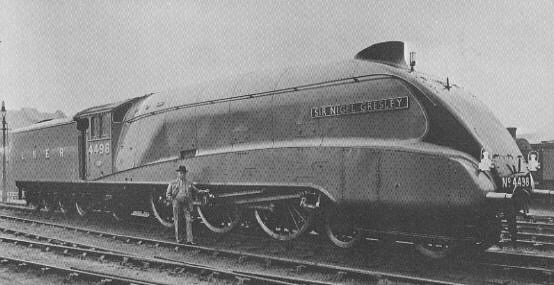
Genesis
By the 1930s, the railways were beginning to see increased competition from road and air travel. It was clear that services between the major cities had to be faster, more reliable, and more comfortable.

Also, a number of high-speed diesel trains were attracting the world's headlines. In May 1933, the German State Railways diesel-electric Fliegende Hamburger entered service, with long stretches of 85mph required by the scheduled timetable. By 1934, the US Burlington Zephyr had reached 112.5mph during a longer 1015 mile journey.
Gresley travelled on the Fliegende Hamburger and was impressed by the need for streamlining, although he realised it was only useful at the highest speeds. From this, he calculated that a streamlined and modified A3 design would be able to haul trains of eight or nine carriages at similar speeds. Both the Fliegende Hamburger and Burlington Zephyr were much smaller (2 and 3 carriage units respectively).
A series of trials were carried out, to confirm that a modified A3 design would be sufficient. During these, A1 Flying Scotsman broke 100mph, and A3 Papyrus managed average speeds almost as fast as Fliegende Hamburger but with a larger coach capacity! On this latter run, Papyrus managed to set a speed record of 108mph. With these trials under his belt, the LNER Board gave Gresley the go-ahead to create the "Silver Jubilee" streamlined trains.
The "Silver Jubilee" was designed as a complete streamlined train including streamlined coaches. These had valences between the bogies and flexible covers over the coach ends. Although this restricted their use, it maximised the streamlining effects and proved useful for publicity! The train had capacity for 198 passengers on 7 coaches: twin-articulated brake third, triple-articulated restaurant set, and a twin-articulated first class.

The wedge-shaped streamlining on the A4 was inspired by a Bugatti rail-car which Gresley had observed in France. The design was refined with the help of Prof. Dalby and the wind tunnel facilities at the National Physical Laboratory (NPL) at Teddington. As well as streamlining, it was important that the design lifted smoke up away from the cab. At first, there was a lot of difficulty in achieving this. Even smoke deflectors were considered! During the wind tunnel tests, it was noticed that a thumb print had inadvertently been added to the plasticine model, just behind the chimney. Only on impulse, was the model re-tested with the thumb print. Amazingly, the smoke was lifted well clear of the cab!
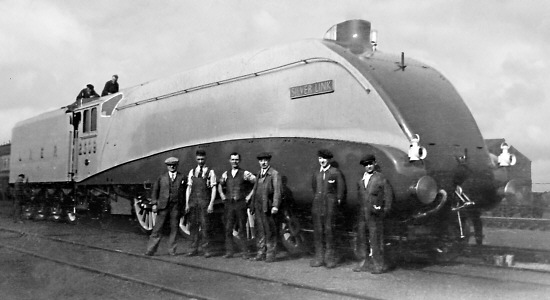
The LNER publicity machine had a field day with the new streamlined shape. Many saw this publicity as mere hype. Some thought the LNER was bowing to the latest craze. Others thought that it was not true streamlining and that the design team did not know what they were doing! In-fact, experimental data showed that a 40% reduction in horsepower was required when powering from 60mph to 150mph. The high speed of 150mph was used to simulate a headwind. This saving ranged from 41hp at 60mph to 639hp at 150mph.
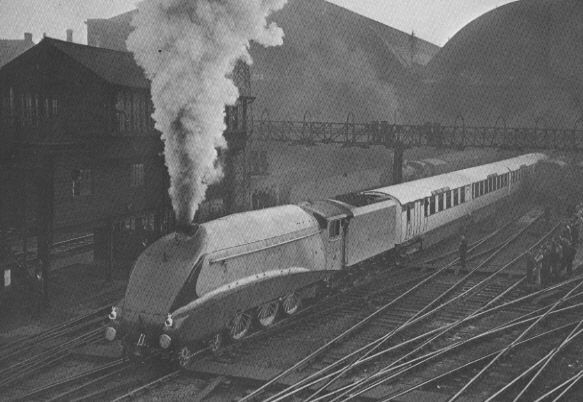
As well as the characteristic streamlining, a number of other things were modified from the A3 design. All of the steam passages were streamlined. The boiler pressure was increased from 220psi to 250psi. The cylinders were decreased slightly in size so that the valve diameters could be increased to 9 inches. This produced free steaming within the restrictions of the 3 cylinder design. As with the A3, Walschaerts gear was used on the outside cylinders, and Gresley's conjugated gear was used for the inside cylinder. Further refinements were added at a latter date, including the Kylchap double-blastpipe exhaust,and Westinghouse QSA Brake Valves.

A demonstration run from Kings Cross to Grantham on 27th September 1935 touched 112.5mph. The first service was on the 1st October 1935, hauled by No. 2509 Silver Link. A further three locomotives were built for the Silver Jubilee service to Newcastle. This service was a great success cutting the travel time between Kings Cross and Newcastle down to an amazing 4 hours. This success led to an extension of the service to Edinburgh, and the building of a further five A4s. By 1937, a third service to Leeds & Bradford had commenced. And thus, Britain's first inter-city network of fast train services was born.
Heyday of the A4: the 1930s
The Silver Jubilee service to Newcastle was a success from the beginning. This was because it supplied the public exactly what they wanted - a fast, reliable service between two major cities. Success was so great, that the trains were extended from 7 coaches to 8 coaches. Reliability was such, that it was said that the people of York checked their watches against the characteristic chime whistle of the Silver Jubilee A4 coming through York station.
The Silver Jubilee was also safe. Never in the 4 years (upto World War Two) was it involved in a major mishap. The A4s were also mechanically reliable. On only 10 occasions out of a total of 1952 Silver Jubilee services, did an A4 experience a mechanical problem. Drivers and fireman were happy too. They found the A4s easily took the loads required of them. They also found the footplate very smooth. This was demonstrated on the original publicity run, when the driver & fireman thought they had barely gone above 90mph. In reality they had touched 112mph!!
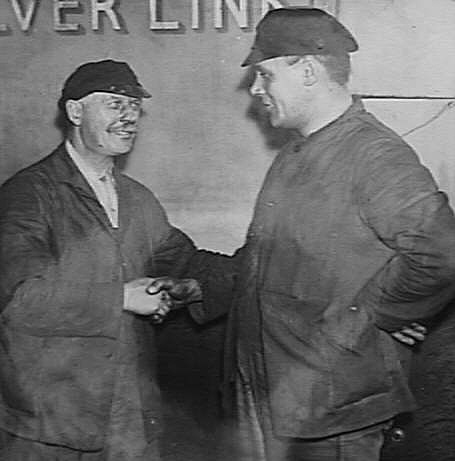
Another A4 trial was performed on 27th August 1936. This time the newest A4, 2512 Silver Fox was chosen, and was driven by Silver Link's George Henry Haygreen. The trial was a scheduled fare-paying service, and was intended to measure water and coal consumption, and to beat Silver Link's 112mph. Total load with the dynamometer car was 270 tons. Alas, they never told George Haygreen that a record attempt was to be attempted on Stoke Bank. This meant he neither had sufficient speed on the run up Stoke Bank, nor was there a sufficient reserve of boiler pressure. By pushing hard, 113mph was reached. This is thought to be a British record for a revenue-earning steam train, but the locomotive had to be pushed hard and the middle big end suffered damage. The train arrived into Kings Cross 7 minutes late. On the return journey, 2509 Silver Link was substituted and arrived 4 minutes early. The results of the trial were that the A4s had a reserve of power, and a 10 coach train would be perfectly feasible for a planned Glasgow-London service.
On 28th June 1937, Stanier's streamlined Coronation Scot of the LMS set a new record of 114mph. Two days later, a press & publicity trip for the LNER's new "Coronation" service pulled by 4489 Dominion of Canada attempted to regain the record. Unfortunately, it only managed to reach 109.5mph on Stoke Bank.
With these increasing speeds, braking distances were getting longer, and so methods to improve braking were investigated. Gresley favoured the use of a system produced by Westinghouse (and already in use on the LMS), and so trials began in 1938. Trials typically required rapid acceleration followed by the brake test. On 3rd July 1938, the Westinghouse team arrived to find that the train consist had changed. Some of the coaches had been removed and replaced with the dynamometer car. Also, the locomotive had been changed to 4468 Mallard. Only 4 months old, this A4 was the first to be fitted with the Kylchap double-blast pipe. The driver was also different - J. Duddington, who had been brought down from Doncaster and had a reputation for running trains hard when it was required. Duddington was joined by fireman T. Bray, and inspector J. Jenkins. When the Westinghouse team were onboard, they were told that they were going to attempt to break the speed record. Why the secrecy? One reason was so that the LMS did not hear of the attempt beforehand. Another might be that the LNER's civil engineering department were not keen on 120+ mph runs, when the track had official speed limits of only 90mph!
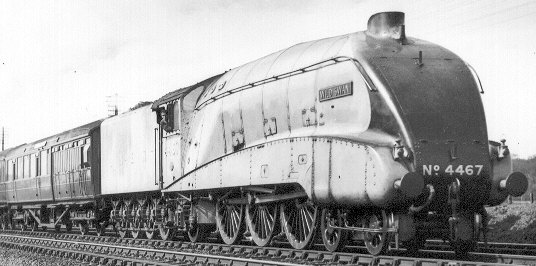
The Down journey consisted of conventional brake tests. At Barkston, the Westinghouse team were given the option of taking a taxi to Peterborough - they all refused! The centre big bearing was drowned in cylinder oil, and the return journey commenced. Grantham was passed at 24mph. By Stoke signal box, the speed had reached 74.5mph with full regulator and 40% cut-off. At milepost 94, 116mph was recorded along with the maximum drawbar of 1800hp. 120mph was achieved between milepost 92.75 and 89.75, and for a short distance of 306 yds, 125mph was touched.
A peak of 126mph was marked on the dynamometer rolls, and this speed was included in some unofficial reports. 126mph is also the speed marked on the plaque BR mounted on Mallard in 1948. Gresley never accepted this speed of 126mph, and thought it misleading. The LNER only claimed a peak average of 125mph - so breaking the world record for steam traction held by the German State Railways (124.5mph) and the British record set by the LMS (114mph).
When Mallard arrived at Peterborough it was found that the centre bearing had overheated. It was then towed to meet the press at Kings Cross behind an Ivatt Atlantic. This must have led to some confusion, but the overheated bearing was quickly re-metalled. A further check was made that everything was okay, and Mallard was back in revenue-earning service within 9 days.
Over 60 years later, Mallard's record of 125mph still stands.
Wartime & British Rail
Although the Second World War did not start until 3rd September 1939, the last streamlined services ran on 31st August 1939 due to the enactment of the Emergency Powers (Defence) Act 1939. In these early days, services were seriously cut back, and the evacuation trains had started. Over the next few months, many services returned but timetables were generally much slower than before the war. Freight took priority, and both blackout conditions and lack of maintenance took their toll on Britain's railways.

Initially the Kings Cross A4s were put into storage, although the other A4s were kept in service. Eventually all of the Kings Cross A4s returned to service. Generally, the A4s were called upon to pull loads much heavier than originally intended. They did this well, although reduced maintenance produced some problems especially with the conjugated gear. To aid maintenance, Thompson removed the side skirts from the A4s. Because the A4s were experiencing much increased loads, they occasionally had problems starting off. To help with this Thompson had the valve gear modified so that a maximum of 75% cut-off was possible. Only 6 locomotives were converted during wartime, with the remainder being converted between 1946 and 1957.
A rather weird wartime change, was the removal of most of the chime whistles. It was thought that these might be confused with air-raid sirens! These were removed in 1942 and destroyed. New chime whistles were built after the war.
On 29th April 1942, 4469 Sir Ralph Wedgwood was severely damaged by bomb blast during an air raid in York. Both No. 4469 and a neighbouring B16 were scrapped, although the tender from No. 4469 was kept and later used on Thompson A2/1 3696.
An attempt to renumber the A4s was proposed by Thompson in 1943. Implementation only started after the war in 1946. Even then, only a handful were renumbered before a new numbering system was chosen by the LNER, with the "premier" A4s taking numbers 1 to 34. This was implemented in the latter half of 1946.
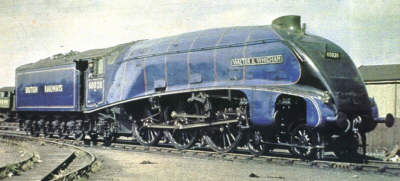
In 1948, the railways were Nationalised and the A4s came under the control of BR. The A4s were renumbered again, by adding the prefix of "600".
In the summer of 1948, BR performed a series of locomotive trials, comparing the different classes of the Big Four companies. The A4s produced some good results and had the lowest coal and water consumption figures of any of the expresses. Unfortunately, there were three A4 failures - all related to the conjugated motion. These are thought to have been due to poor wartime maintenance. The Gresley's conjugated motion worked well if it received good maintenance.
Also during the summer of 1948, there were attempts to restart the non-stop services. In August 1948, serious flooding caused the collapse of a number of bridges and culverts on the East Coast mainline in south east Scotland. Hence, many of the trains were diverted via Selby and Leeds, over the Settle-Carlisle line. From 24th August, the A4's non-stop run was diverted over the Waverley route to St. Boswells, then via Kelso to Tweedmouth to rejoin the mainline. On this first run, No. 60028 Walter K. Wigham managed to run nonstop from Edinburgh to Kings Cross, a record setting distance of 408.65 miles. These runs required some luck as regards running and signals, but the drivers took great pride in achieving a nonstop run. The following runs set the nonstop record:
| Direction | Date | Locomotive | Direction | Date | Locomotive |
| Southbound: | 24 Aug | 60028 Walter K. Whigham | Northbound: | 25 Aug | 60028 Walter K. Whigham |
| 26 Aug | 60028 Walter K. Whigham | 26 Aug | 60027 Merlin | ||
| 28 Aug | 60029 Woodcock | 27 Aug | 60029 Woodcock | ||
| 7 Sep | 60029 Woodcock | 2 Sep | 60029 Woodcock | ||
| 9 Sep | 60029 Woodcock | 6 Sep | 60029 Woodcock | ||
| 11 Sep | 60012 Commonwealth of Australia | 7 Sep | 60012 Commonwealth of Australia | ||
| 15 Sep | 60022 Mallard | 8 Sep | 60029 Woodcock | ||
| 17 Sep | 60029 Woodcock | 9 Sep | 60031 Golden Plover | ||
| 18 Sep | 60012 Commonwealth of Australia |
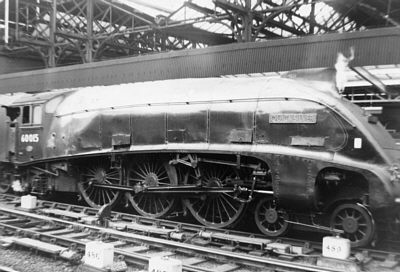
These records would hold until A3 No. 4472 Flying Scotsman's visit to Australia in 1988.
During the late 1940s and early 1950s, maintenance of the locomotives and the permanent way improved, so facilitating speed increases of the A4s. Prewar speeds were never reached, although in 1959, 60007 Sir Nigel Gresley set a post-war steam speed record of 112mph. By the late 1950s, steam was being replaced by diesel power. Although the Deltics proved worthy successors of the A4s on East Coast Mainline express services, other diesel classes were generally very poor and often failed. Hence, the A4s were kept in service until the mid-1960s. The first A4s were scrapped at the end of 1962. These were from Kings Cross and had been directly replaced by the Deltics. The last BR A4 service was on 14th September 1966 between Aberdeen and Glasgow.
Technical Details
The tender details are for the corridor version of the streamlined A4 tender.
| Cylinders (x3): | 18.5x26in. | |
| Motion: | Outside: | Walschaerts |
| Inside: | Gresley | |
| Piston Valves: | 9in. diameter | |
| Boiler: | Max. Diameter: | 6ft 5in |
| Pressure: | 250psi | |
| Diagram No.: | 107 | |
| Heating Surface: | Total: | 3325.2 sq.ft. |
| Firebox: | 231.2 sq.ft. | |
| Superheater: | 748.9 sq.ft. | |
| Tubes: | 1281.4 sq.ft. (121x 2.25in) | |
| Flues: | 1063.7 sq.ft. (43x 5.25in) | |
| Grate Area: | 41.25 sq.ft. | |
| Wheels: | Leading: | 3ft 2in |
| Coupled: | 6ft 8in | |
| Trailing: | 3ft 8in | |
| Tender: | 4ft 2in | |
| Tractive Effort: | 35,455lb | (@ 85% boiler pressure) |
| Wheelbase: | Total: | 60ft 10.6in |
| Engine: | 35ft 9in | |
| Tender: | 16ft | |
| Weight (full): | Total: | 167 tons 2cwt |
| Engine: | 102 tons 19cwt | |
| Tender: | 64 tons 3cwt | |
| Max. Axle Load: | 22 tons | |
| Water Capacity: | 5000 gallons | |
| Coal Capacity: | 8 tons |
Livery
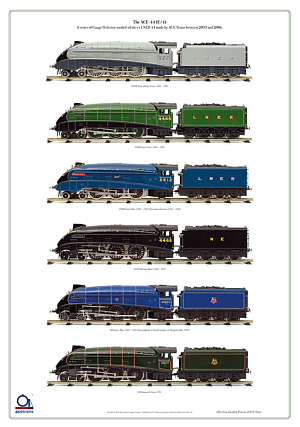
Click for larger image
The A4s probably carried the most liveries of any LNER locomotives - especially in the relatively short time that they were in operation. The Ace Trains poster to the right illustrates the main liveries. Variations are complicated, and readers should consult the RCTS Locomotives of the LNER, or Yeadon's Register for specific details and dates.
The original four 'silver' A4s were painted in a striking silver and grey livery. The main colour was silver grey, with charcoal grey for the smokebox front, and battleship grey for the skirts and frames.
Later A4s were initially painted in variations of the LNER Doncaster green livery. The most common livery has a parabolic curve between the smokebox black and boiler green. Five A4s initially had a straight boundary when there were concerns about the green paint withstanding the smokebox temperatures. The effect looked wrong, and these concerns proved to be ill-founded.
The May 1937 batch was painted in a new garter blue livery. The parabolic curve was kept. Wheel centres were red. The livery was very effective and was later adopted as the standard livery for the A4s. This is the most famous of A4 liveries.
Wartime black 'NE' livery was used during World War 2 as an austerity measure, in common with other express locomotives.
The A4s returned to garter blue after World War 2, but this was relatively short lived. With Nationalisation (1948), BR painted the A4s in white-lined 'Express Blue'. During a period of livery trials, 'BR Purple' was also used on four A4s. 'Purple' was a poor name and the colour was closer to GER Blue. The final A4 livery was that of the the standard BR green livery with orange and black lining from August 1951.
Preservation


The A4s have always been a popular class of steam locomotive, and this probably explains why more A4s survive than any other LNER class. Three are in mainline working condition, and two have even made it over to North America!
4464 (BR 60019) Bittern has just completed a major overhaul on the Mid-Hants (Watercress) Line, and in 2007 returned to running condition for the first time since the 1970s. Previous to this overhaul, Bittern spent an extensive time cosmetically restored as No. 2509 Silver Link. Bittern can usually be seen in either the BR green or LNER garter blue liveries.
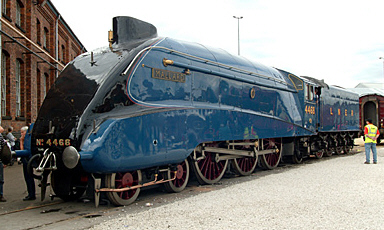
4468 (BR 60022) Mallard is a part of the National Collection and can usually be seen at York. She was restored to mainline condition for the 50th Anniversary of her record breaking run, but the boiler certificate has since expired. Due to the expense of keeping her in running condition and the popularity of her as an exhibit at York, she will be kept in a static condition for the foreseeable future.
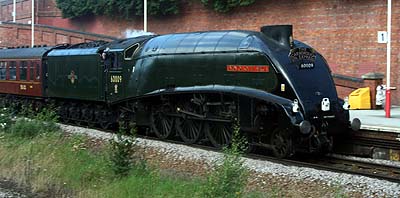
4488 (BR 60009) Union of South Africa is owned by John Cameron. Based at Bridgenorth on the Severn Valley Railway, it regularly appears on main line steam specials.
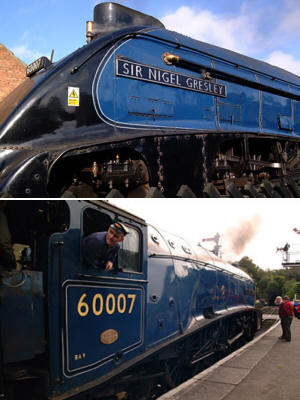

4498 (BR 60007) Sir Nigel Gresley is owned by the A4 Locomotive Society. It is currently kept at the North Yorkshire Moors Railway, and has recently undergone an overhaul to mainline condition. Sir Nigel Gresley holds a number of post-war steam speed records, both with BR and in private hands!
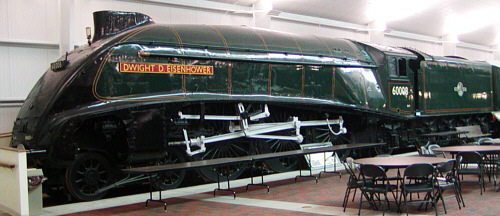
4496 (BR 60008) Dwight D Eisenhower visited the UK during 2013 for the 75th Anniversary of Mallard's record breaking run. During the visit, the (York) National Railway Museum restored it to BR Green condition. It has since returned to its home at the National Railroad Museum at Green Bay, Wisconsin. 4496 was originally named Golden Shuttle, but was renamed in September 1945.
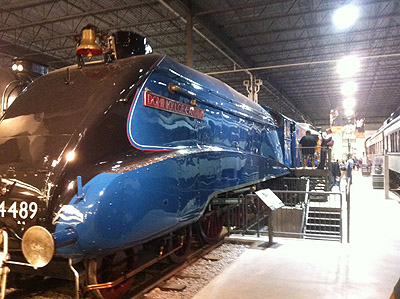
4489 (BR 60010) Dominion of Canada visited the UK during 2013 for the 75th Anniversary of Mallard's record breaking run. During the visit, the (York) National Railway Museum restored it back to 1930s condition in LNER Garter Blue complete with the ceremonial bell. It has since returned to the Exporail Canadian Railway Museum.
Models
Graham Farish (now Bachmann) and Minitrix have both produced ready-to-run models of the A4 for N Gauge (2mm), and Dapol currently have an N Gauge A4 in production.
3SMR produce a 3mm scale white metal kit of the A4.
Both Bachmann and Hornby sell ready to run OO (4mm) models of the A4. Hornby's short-lived live steam OO range also included an A4. SE Finescale sell a whitemetal kit for 4mm scale that comes with the 1928 tender. Proscale have produced a kit of the A4 for OO gauge, but current availability is unknown.
Martin Finney sell kits of the A4 for both the 4mm and 7mm scales.
7mm (O gauge) ready to run models of the A4 are available from Ace Trains, Sunset Models, and LH Loveless. Kits are available from ACE Products, DJH, and Right Price Railway.
Accucraft UK, Ltd have announced an A4 for Gauge 1.
Locomotives
Most of the A4s carried three different numbers: the original LNER numbers; 1946 renumbering; and the BR renumbering (1948/9). A handful of engines were also renamed. Dates of renaming are in brackets.
The disposal date is that of sale (for preservation) or destruction (No. 4469 suffered bomb damage).
4469 was withdrawn after bomb damage in June 1942. The name was transferred to 4466.
4901 was renamed from Charles H. Newton to Sir Charles Newton on 4th June 1943 to correspond with his knighthood.
| LNER No. | 1946 No. | BR No. | Disposal Date | Name | Second Name (Date) |
| 2509 | 14 | 60014 | 1962 | Silver Link | |
| 2510 | 15 | 60015 | 1963 | Quicksilver | |
| 2511 | 16 | 60016 | 1965 | Silver King | |
| 2512 | 17 | 60017 | 1963 | Silver Fox | |
| 4462 | 4 | 60004 | 1966 | Great Snipe | William Whitelaw (7/1941) |
| 4463 | 18 | 60018 | 1963 | Sparrow Hawk | |
| 4464 | 19 | 60019 | 1966 | Bittern | |
| 4465 | 20 | 60020 | 1964 | Guillemot | |
| 4466 | 6 | 60006 | 1965 | Herring Gull | Sir Ralph Wedgwood (1/1944) |
| 4467 | 21 | 60021 | 1964 | Wild Swan | |
| 4468 | 22 | 60022 | 1963 | Mallard | |
| 4469 | 1942 | Gadwall | Sir Ralph Wedgwood (3/1939) | ||
| 4482 | 23 | 60023 | 1964 | Golden Eagle | |
| 4483 | 24 | 60024 | 1966 | Kingfisher | |
| 4484 | 25 | 60025 | 1964 | Falcon | |
| 4485 | 26 | 60026 | 1967 | Kestrel | Miles Beevor (11/1947) |
| 4486 | 27 | 60027 | 1965 | Merlin | |
| 4487 | 28 | 60028 | 1963 | Sea Eagle | Walter K. Whigham (10/1947) |
| 4488 | 9 | 60009 | 1966 | Osprey | Union of South Africa (6/1937) |
| 4489 | 10 | 60010 | 1967 | Woodcock | Dominion of Canada (6/1937) |
| 4490 | 11 | 60011 | 1964 | Empire of India | |
| 4491 | 12 | 60012 | 1965 | Commonwealth of Australia | |
| 4492 | 13 | 60013 | 1965 | Dominion of New Zealand | |
| 4493 | 29 | 60029 | 1964 | Woodcock | |
| 4494 | 3 | 60003 | 1963 | Osprey | Andrew K. McCosh (10/1942) |
| 4495 | 30 | 60030 | 1963 | Great Snipe | Golden Fleece (9/1937) |
| 4496 | 8 | 60008 | 1966 | Golden Shuttle | Dwight D. Eisenhower (9/1945) |
| 4497 | 31 | 60031 | 1965 | Golden Plover | |
| 4498 | 7 | 60007 | 1966 | Sir Nigel Gresley | |
| 4499 | 2 | 60002 | 1964 | Pochard | Sir Murrough Wilson (4/1939) |
| 4500 | 1 | 60001 | 1964 | Garganey | Sir Ronald Matthews (3/1939) |
| 4900 | 32 | 60032 | 1963 | Gannet | |
| 4901 | 5 | 60005 | 1964 | Capercaillie | Charles H. Newton (9/1942) |
| 4902 | 33 | 60033 | 1963 | Seagull | |
| 4903 | 34 | 60034 | 1966 | Peregrine | Lord Faringdon (3/1948) |
Acknowledgements
Thank you to Paul J Haygreen for the photograph of his grandfather George Henry Haygreen, and further information about the Silver Fox record attempt.
Thank you to Gerry Taylor for the first two sound samples.
Thank you to Geoff Byman FRPS for the third sound sample, and the preservation era photographs of No. 4468 Mallard and No. 60007 Sir Nigel Gresley.
Thank you to Dennis Butler for the photograph of A4 No. 4467 Wild Swan.
Thank you to John Massey for the above photograph of the recently restored No. 4489 Dominion of Canada.
Thank you to Peter Langsdale for the photograph of No. 60008 Dwight D. Eisenhower at Green Bay, Wisconsin.
Thank you to the Mike Morant Collection for the photograph of BR No. 60019 Bittern cosmetically restored as No. 2509 Silver Link.
Thank you to Mark Turner for the photograph and sound recording of BR No. 60019 Bittern at York in December 2007.
Thank you to Malcolm Peirson for the photographs of No. 60028 Walter K. Whigham in early BR blue livery, Silver Link being serviced.
Thank you to Ace Trains for permission to use an image of their A4 livery poster.
Thank you to Julie Bridges for the unofficial photograph of the brand new No. 2509 Silver Link fresh out of the Doncaster paint shop in 1935.
Further References
"The Streaks, Gresley's A4s", Roger J. Mannion, publ. Sutton Publishing
British Pathe have a film of No. 60007 Sir Nigel Gresley being tested at the new Rugby Test Station in 1948.